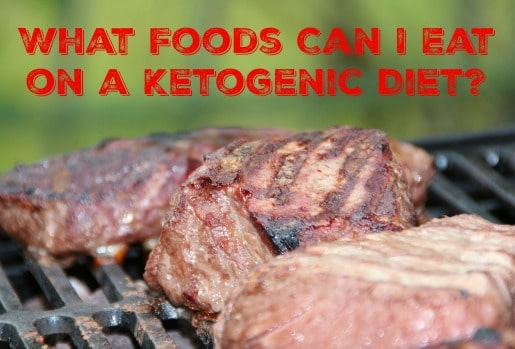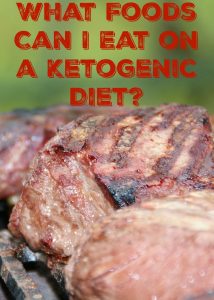In the past when I answered this question, I just linked to the infamous “Dr Eric Westman’s Page 4” list but as someone pointed out to me last week, that list is no longer available on Scribd where it has been for years. A stunning loss to the Ketogenic world! However, I kept a copy in my personal notes so we are golden. I will not be copy and pasting his list here just because it is his list and I’m not sure how Dr Westman would feel about me just repeating his list here but I can assure you that all the information below is very similar to his list but just redone in my own words so as not to step on anyone’s copyright toes. Plus, let’s be honest, a list of keto friendly foods is pretty easy to come up with. Eat fatty meats, green leafy veggies and some full fat dairy. You can see my recipes at MySugarFreeJourney.com/Recipes.
Your diet is to be made up exclusively of foods and beverages from the following list.
No more than 20 grams of carbs a day.
- If the food is packaged, check the label for carbohydrate count for your meal. You are looking for:
- – 2 grams or less for meat and dairy products,
- – 5 grams or less for vegetables.
All food may be cooked in a microwave oven, baked, boiled, stir-fried, sautéed, roasted, fried (with no flour, breading, or cornmeal), or grilled.
When You Are Hungry, Eat Your Choice Of The Following Foods…
Meat
- Beef (including hamburger and steak)
- Pork, ham (unglazed), bacon,
- Lamb, veal, or other meats.
- For processed meats (sausage, pepperoni, hot dogs), check the label for carb counts (Stay away from processed meats with added sugar or grains)
- Carbohydrate count should be about 1 gram per serving
Poultry
- Chicken
- Turkey
- Duck
- Any other fowl
Fish and Shellfish
- Any fish, including
- Tuna
- Salmon
- Catfish
- Bass
- Trout
- Shrimp
- Scallops
- Crab
- Lobster
- Sardines (Aarn’s personal favorite: Wild Planet)
Eggs
Whole eggs are permitted without restrictions
Foods That Should Be Eaten Every Day…
Salad Greens
- 1-2 cups a day (maximum 2 cups or two fistfuls)
- – Cabbage (all varieties)
- – Chives
- – Greens (all varieties, including beet, collards, mustard, and turnip)
- – Lettuce (all varieties)
- – Parsley
- – Spinach
- – Radishes
(If it is a leaf, you may eat it.)
Fibrous Non-Starchy Vegetables:
1 cup (one fistful) per day
includes:
- – Asparagus
- – Black beans (only a few in chili etc.)
- – Broccoli
- – Brussels sprouts
- – Bamboo shoots
- – Bean sprouts
- – Cauliflower
- – Celery
- – Cucumber
- – Green beans (string beans)
- – Mushrooms
- – Okra
- – Pepper
- – Rhubarb
- – Rutabaga (swede)
- – Snow peas
- – Sprouts (bean and alfalfa)
- – Sugar snap peas
- – Zucchini
- – Tomatoes
- – Turnip
- – Wax beans
Foods Allowed In Limited Quantities…
Cheese
- Up to 4 ounces a day.
- Includes hard, aged cheeses such as Swiss and Cheddar,
- Brie, Camembert blue, mozzarella, Gruyere, cream cheese, goat cheeses.
- Avoid processed cheeses, such as Velveeta.
- Check the label; carbohydrate count should be less than 1 gram per serving.
- Try to stick with Full Fat varieties
Cream (no milk)
- Up to 2 tablespoons a day.
- Includes heavy, light, or sour cream
- Not half and half
Mayonnaise
- Up to 3 tablespoons a day.
- Duke’s and Hellmann’s are low-carb.
- Check the labels of other brands.
- Aarn’s recommendation: Primal Kitchen brand
Fatty Vegetables & Other
- Avocado- ½ per day
- Olives (Black or Green): – Up to 6 a day.
Condiments
- Lemon/Lime Juice: Up to 2 teaspoonfuls a day.
- Ketchup: In very small amounts (Heinz makes a version sweetened with Sucralose that is very good)
- Soy Sauces: Up to 2 tablespoons a day. (To avoid problems with Soy, consider switching to Coconut Aminos)
Pickles
- Dill or Sugar-Free:
- Up to 2 servings a day.
- Mt. Olive makes sugar-free pickles.
- Check the labels for carbohydrates and serving size.
Snacks
Pepperoni slices, Pork Rinds, Ham, Beef, Turkey, Other meat roll-ups with cream cheese, Deviled eggs, Summer Sausage or Salami (less than 1 gram carb)
RESTRICTIONS: Do Not Eat!
On this diet, no sugars (simple carbohydrates) and no starches (complex carbohydrates) are eaten. The only carbohydrates encouraged are the nutritionally dense, fiber-rich vegetables listed.
Sugars: Simple carbohydrate Avoid anything containing:
- – White sugar
- – Brown sugar
- – Honey
- – Maple syrup
- – Molasses
- – Corn syrup
- – Beer (contains barley malt)
- – Milk (contains lactose)
- – Flavored yogurts (usually have a lot of sugar)
- – Fruit juice
- – Fruit
Starches: “complex” carbohydrate
- Avoid these kinds of foods:
- – Grains (even “whole” grains),
- – Rice
- – Cereals and Oatmeal
- – Flour
- – Corn
- – Cornstarch
- – Breads
- – Pastas
- – Muffins
- – Bagels
- – Crackers
- – Beans and peas (pinto, lima, kidney, peas etc)
- – Most Root vegetables – particularly carrots, parsnips, corn, potatoes, French fries, potato
- chips
SWEETENERS AND DESSERTS
- If you feel the need to eat or drink something sweet, you should select the most sensible alternative sweetener(s) available.
- Available alternative sweeteners are:
- – Splenda (sucralose),
- – Nutra-sweet (aspartame), (I include this for the sake of completeness but don’t use Aspartame. There are numerous documented problems with it)
- – Truvia (stevia/erythritol blend), (Aarn’s choice)
- – Sweet ‘N Low (saccharin). (Aarn’s 2nd choice)
- – Xylitol (Dian’s choice for her coffee)
IMPORTANT TIPS AND REMINDERS
- The following items are NOT on the diet:
- – Sugar
- – Bread
- – Cereal
- – Flour-containing items
- – Fruits, juices
- – Honey
- – Whole or skimmed milk
- – Yogurt
- – Canned soups
- – Dairy substitutes
- – Sweet condiments and relishes
FATS AND OILS
- All fats and oils, even butter, are allowed. Some oils are better for cooking
- Coconut oil, butter, Ghee or lard is recommended for cooking as these are most stable at high temperatures
- Olive oil is recommended for cold dressings.
- Avoid margarine and other hydrogenated oils that contain trans fats – they are not healthy.
- For salad dressings, the ideal dressing is a homemade oil-and-vinegar dressing, with lemon juice and spices as needed.
- Blue-cheese, ranch, Caesar, and Italian are also acceptable if the label says 1 to 2 grams of carbohydrate per serving or less. (Again, consider Primal Kitchen dressings)
- Avoid “lite” dressings, because these commonly have more carbohydrate.
Chopped eggs, bacon, and/or grated cheese may also be included in salads as a fat source
- Natural unprocessed fats, in general, are important to include, because they taste good and make you feel full.
- You are therefore permitted the fat or skin that is served with the meat or poultry that you eat, as long as there is no breading on the skin.
- Do not attempt to follow a low-fat diet!
Quantities
- Eat when you are hungry; stop when you are full.
- The diet works best on a “demand feeding” basis—that is, eat whenever you are hungry; try not to eat more than what will satisfy you.
- Learn to listen to your body. A low-carbohydrate diet has a natural appetite-reduction effect to ease you into the consumption of smaller and smaller quantities comfortably.
- Do not eat everything on your plate just because it’s there. On the other hand, don’t go hungry!
- You are not counting calories. Enjoy losing weight comfortably, without hunger or cravings.
- It is recommended that if you are hungry you start your day with a nutritious low-carbohydrate meal.
- Note that many medications and nutritional supplements need to be taken with food at each meal, or three times per day.
Don’t miss a post! Click here to sign up for our daily email!




2 thoughts on “What Foods Can I Eat on a Ketogenic Diet?”
-
Pingback: What is the Ketogenic Diet? A Beginner's Guide! | My Sugar Free Journey
-
Pingback: What Snack Foods Can I Eat on the Ketogenic Diet? | My Sugar Free Journey
Leave a Reply